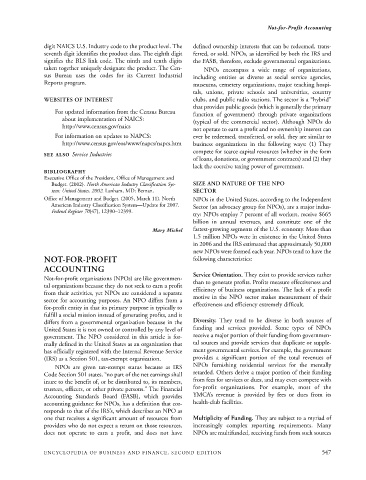Page 570 - Encyclopedia of Business and Finance
P. 570
eobf_N 7/5/06 3:16 PM Page 547
Not-for-Profit Accounting
digit NAICS U.S. Industry code to the product level. The defined ownership interests that can be redeemed, trans-
seventh digit identifies the product class. The eighth digit ferred, or sold. NPOs, as identified by both the IRS and
signifies the BLS link code. The ninth and tenth digits the FASB, therefore, exclude governmental organizations.
taken together uniquely designate the product. The Cen- NPOs encompass a wide range of organizations,
sus Bureau uses the codes for its Current Industrial including entities as diverse as social service agencies,
Reports program. museums, cemetery organizations, major teaching hospi-
tals, unions, private schools and universities, country
WEBSITES OF INTEREST clubs, and public radio stations. The sector is a “hybrid”
that provides public goods (which is generally the primary
For updated information from the Census Bureau function of government) through private organizations
about implementation of NAICS: (typical of the commercial sector). Although NPOs do
http://www.census.gov/naics
not operate to earn a profit and no ownership interest can
For information on updates to NAPCS: ever be redeemed, transferred, or sold, they are similar to
http://www.census.gov/eos/www/napcs/napcs.htm business organizations in the following ways: (1) They
compete for scarce capital resources (whether in the form
SEE ALSO Service Industries
of loans, donations, or government contracts) and (2) they
lack the coercive taxing power of government.
BIBLIOGRAPHY
Executive Office of the President, Office of Management and
Budget. (2002). North American Industry Classification Sys- SIZE AND NATURE OF THE NPO
tem: United States, 2002. Lanham, MD: Bernan. SECTOR
Office of Management and Budget. (2005, March 11). North NPOs in the United States, according to the Independent
American Industry Classification System—Update for 2007. Sector (an advocacy group for NPOs), are a major indus-
Federal Register 70(47), 12390–12399.
try: NPOs employ 7 percent of all workers, receive $665
billion in annual revenues, and constitute one of the
Mary Michel fastest-growing segments of the U.S. economy. More than
1.5 million NPOs were in existence in the United States
in 2006 and the IRS estimated that approximately 50,000
new NPOs were formed each year. NPOs tend to have the
NOT-FOR-PROFIT following characteristics:
ACCOUNTING
Service Orientation. They exist to provide services rather
Not-for-profit organizations (NPOs) are like governmen- than to generate profits. Profits measure effectiveness and
tal organizations because they do not seek to earn a profit
from their activities, yet NPOs are considered a separate efficiency of business organizations. The lack of a profit
sector for accounting purposes. An NPO differs from a motive in the NPO sector makes measurement of their
for-profit entity in that its primary purpose is typically to effectiveness and efficiency extremely difficult.
fulfill a social mission instead of generating profits, and it
differs from a governmental organization because in the Diversity. They tend to be diverse in both sources of
United States it is not owned or controlled by any level of funding and services provided. Some types of NPOs
government. The NPO considered in this article is for- receive a major portion of their funding from governmen-
mally defined in the United States as an organization that tal sources and provide services that duplicate or supple-
has officially registered with the Internal Revenue Service ment governmental services. For example, the government
(IRS) as a Section 501, tax-exempt organization. provides a significant portion of the total revenues of
NPOs furnishing residential services for the mentally
NPOs are given tax-exempt status because as IRS
retarded. Others derive a major portion of their funding
Code Section 501 states, “no part of the net earnings shall
inure to the benefit of, or be distributed to, its members, from fees for services or dues, and may even compete with
trustees, officers, or other private persons.” The Financial for-profit organizations. For example, most of the
Accounting Standards Board (FASB), which provides YMCA’s revenue is provided by fees or dues from its
accounting guidance for NPOs, has a definition that cor- health-club facilities.
responds to that of the IRS’s, which describes an NPO as
one that receives a significant amount of resources from Multiplicity of Funding. They are subject to a myriad of
providers who do not expect a return on those resources, increasingly complex reporting requirements. Many
does not operate to earn a profit, and does not have NPOs are multifunded, receiving funds from such sources
ENCYCLOPEDIA OF BUSINESS AND FINANCE, SECOND EDITION 547

